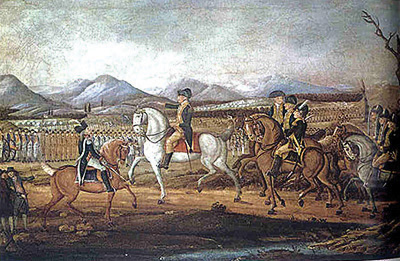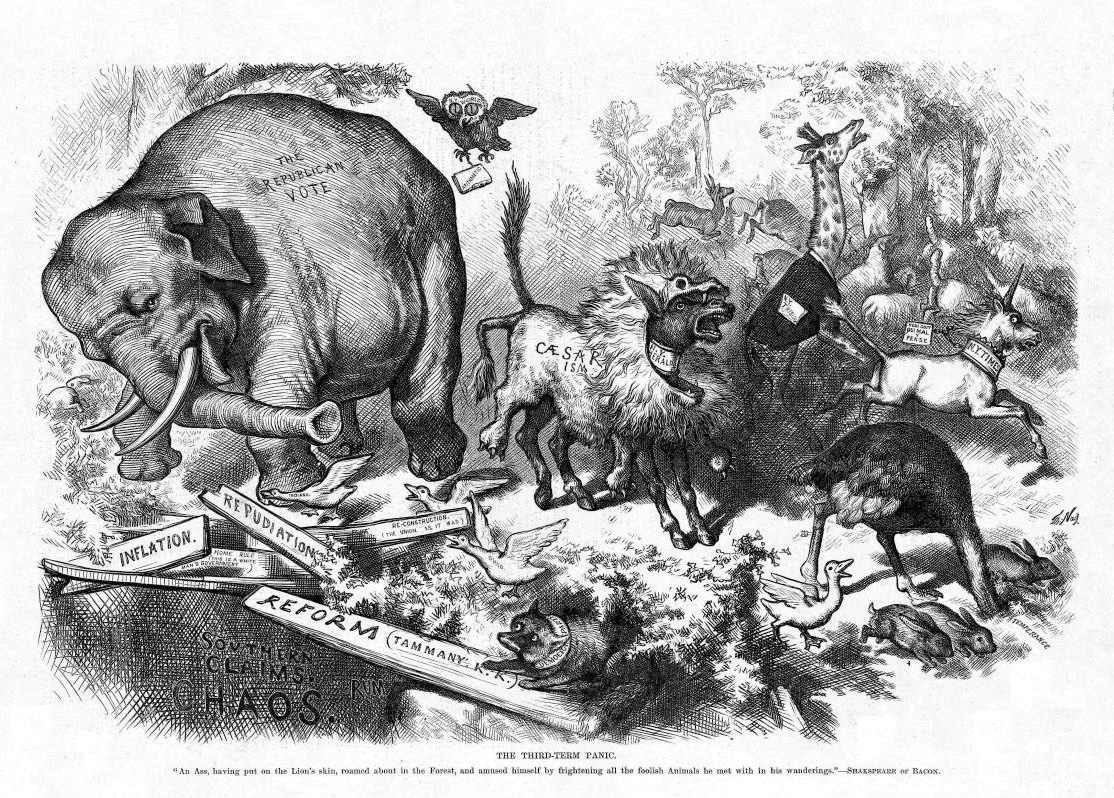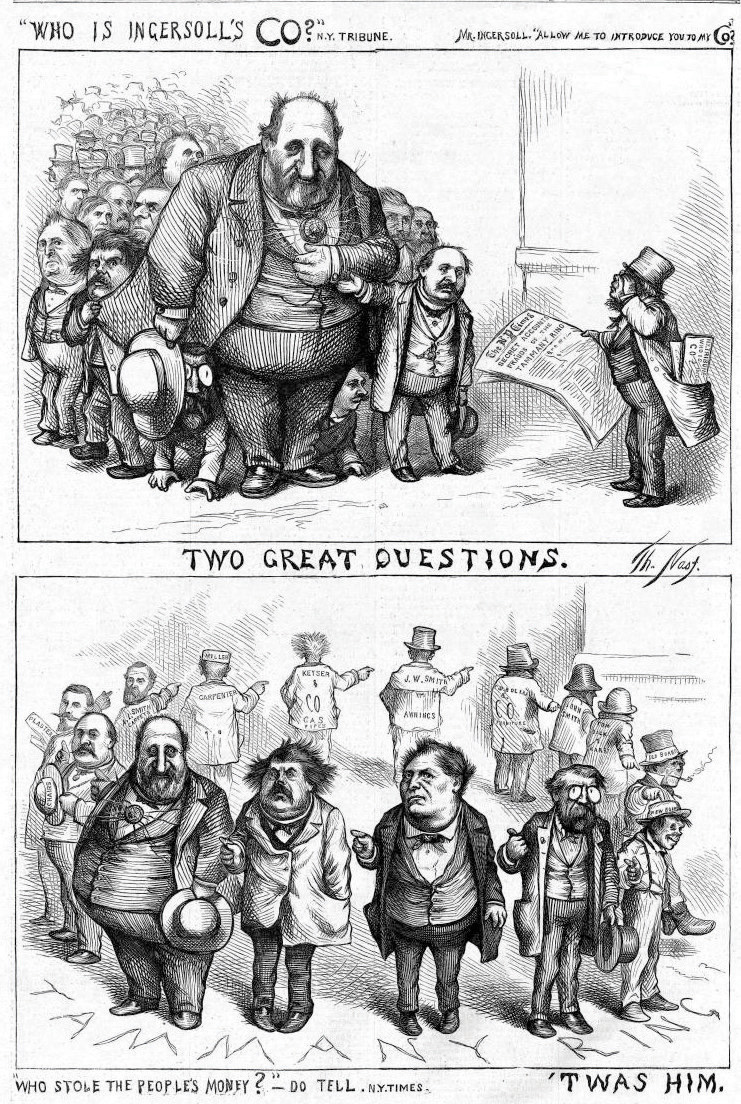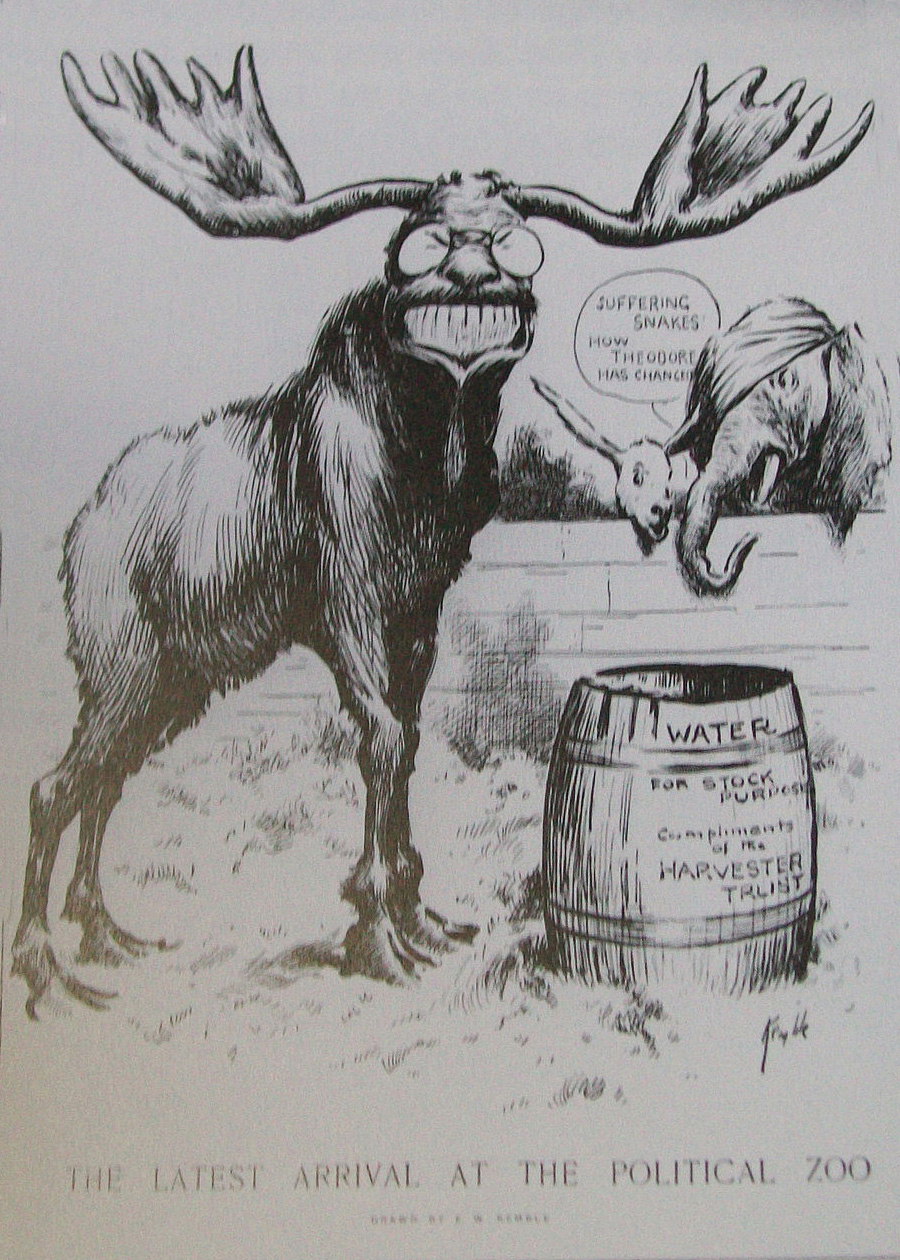Guided Reading Lesson 1 Growth of American Parties
x.1 History of American Political Parties
Learning Objectives
After reading this section, you should be able to answer the following questions:
- What is a political party?
- What were James Madison's fears about political factions?
- How did American political parties develop?
- How did political machines function?
Political parties are enduring organizations nether whose labels candidates seek and hold elective offices (Epstein, 1986). Parties develop and implement rules governing elections. They assist organize authorities leadership (Central Jr., 1964). Political parties accept been likened to public utilities, such as water and ability companies, because they provide vital services for a democracy.
The endurance and adaptability of American political parties is all-time understood by examining their colorful historical development. Parties evolved from factions in the eighteenth century to political machines in the nineteenth century. In the twentieth century, parties underwent waves of reform that some argue initiated a period of reject. The renewed parties of today are service-oriented organizations dispensing help and resources to candidates and politicians (Aldrich, 1995; Eldersveld & Walton Jr., 2000).
Fear of Faction
The founders of the Constitution were fearful of the rise of factions, groups in society that organize to advance a political agenda. They designed a government of checks and balances that would foreclose any one grouping from becoming besides influential. James Madison famously warned in Federalist No. 10 of the "mischiefs of faction," particularly a large majority that could seize control of government (Publius, 2001). The suspicion of parties persisted among political leaders for more than a half century afterwards the founding. President James Monroe opined in 1822, "Surely our government may go on and prosper without the existence of parties. I have always considered their existence as the curse of the country" (Hofstadter, 1969).
Figure 10.1
<<a href="/app/uploads/sites/193/2016/10/533c8686f8d280ce42699201aeb7f938.jpg">img src="https://open.lib.umn.edu/app/uploads/sites/193/2016/ten/533c8686f8d280ce42699201aeb7f938.jpg" width="300″ alt="A newspaper cartoon depicting conflicts that arose between the Federalists and Republicans, who sought to command the government."/>
Paper cartoons depicted conflicts that arose between the Federalists and Republicans, who sought to command government.
Despite the ambiguous feelings expressed by the founders, the commencement modernistic political party, the Federalists, appeared in the United States in 1789, more iii decades before parties developed in Great United kingdom of great britain and northern ireland and other western nations (Chambers & Burnham, 1975). Since 1798, the United States has only experienced i brief period without national parties, from 1816 to 1827, when infighting following the War of 1812 tore apart the Federalists and the Republicans (Chambers, 1963).
Parties equally Factions
The first American party system had its origins in the period following the Revolutionary War. Despite Madison's alert in Federalist No. x, the first parties began every bit political factions. Upon taking role in 1789, President George Washington sought to create an "aware administration" devoid of political parties (White & Shea, 2000). He appointed two political adversaries to his chiffonier, Alexander Hamilton every bit treasury secretary and Thomas Jefferson as secretary of country, hoping that the two great minds could piece of work together in the national involvement. Washington's vision of a government without parties, however, was brusque-lived.
Hamilton and Jefferson differed radically in their approaches to rectifying the economic crisis that threatened the new nation (Charles, 1956). Hamilton proposed a series of measures, including a controversial taxation on whiskey and the institution of a national banking company. He aimed to have the federal government assume the unabridged burden of the debts incurred past the states during the Revolutionary War. Jefferson, a Virginian who sided with local farmers, fought this suggestion. He believed that moneyed business organisation interests in the New England states stood to do good from Hamilton'south plan. Hamilton assembled a group of powerful supporters to promote his plan, a group that eventually became the Federalist Party (Hofstadter, 1969).
The Federalists and the Republicans
The Federalist Party originated at the national level merely soon extended to the states, counties, and towns. Hamilton used business and military connections to build the party at the grassroots level, primarily in the Northeast. Because voting rights had been expanded during the Revolutionary War, the Federalists sought to attract voters to their party. They used their newfound system for propagandizing and campaigning for candidates. They established several big-city newspapers to promote their cause, including the Gazette of the U.s., the Columbian Centinel, and the American Minerva, which were supplemented by broadsheets in smaller locales. This partisan printing initiated 1 of the key functions of political parties—articulating positions on issues and influencing public opinion (Chambers, 1963).
Effigy 10.ii The Whiskey Rebellion

Farmers protested against a tax on whiskey imposed by the federal authorities. President George Washington established the power of the federal government to suppress rebellions by sending the militia to stop the uprising in western Pennsylvania. Washington himself led the troops to establish his presidential authority.
Disillusioned with Washington'southward administration, specially its strange policy, Jefferson left the chiffonier in 1794. Jefferson urged his friend James Madison to take on Hamilton in the press, stating, "For God'south sake, my Dear Sir, take up your pen, select your most striking heresies, and cut him to pieces in the face up of the public" (Chambers, 1963). Madison did just that under the pen name of Helvidius. His writings helped fuel an anti-Federalist opposition movement, which provided the foundation for the Republican Party. This early on Republican Political party differs from the present-day party of the same name. Opposition newspapers, the National Gazette and the Aurora, communicated the Republicans' views and actions, and inspired local groups and leaders to align themselves with the emerging party (Chambers, 1963). The Whiskey Rebellion in 1794, staged by farmers angered by Hamilton's tax on whiskey, reignited the founders' fears that violent factions could overthrow the government (Schudson, 1998).
Outset Parties in a Presidential Election
Political parties were kickoff evident in presidential elections in 1796, when Federalist John Adams was barely victorious over Republican Thomas Jefferson. During the election of 1800, Republican and Federalist members of Congress met formally to nominate presidential candidates, a exercise that was a precursor to the nominating conventions used today. As the head of state and leader of the Republicans, Jefferson established the American tradition of political parties as grassroots organizations that band together smaller groups representing various interests, run slates of candidates for role, and nowadays issue platforms (White & Shea, 2000).
The early Federalist and Republican parties consisted largely of political officeholders. The Federalists not only lacked a mass membership base of operations but as well were unable to expand their achieve beyond the monied classes. As a result, the Federalists ceased to be a force afterwards the 1816 presidential election, when they received few votes. The Republican Party, bolstered by successful presidential candidates Thomas Jefferson, James Madison, and James Monroe, was the sole surviving national party past 1820. Infighting soon caused the Republicans to cleave into warring factions: the National Republicans and the Democratic-Republicans (Formisano, 1981).
Establishment of a Party Organization
A true party system with two durable institutions associated with specific ideological positions and plans for running the government did not begin to develop until 1828. The Democratic-Republicans, which became the Democratic Party, elected their presidential candidate, Andrew Jackson. The Whig Political party, an offshoot of the National Republicans, formed in opposition to the Democrats in 1834 (Holt, 2003).
The era of Jacksonian Republic, which lasted until the outbreak of the Civil War, featured the rise of mass-based party politics. Both parties initiated the practice of grassroots candidature, including door-to-door canvassing of voters and party-sponsored picnics and rallies. Citizens voted in record numbers, with turnouts as high as 96 pct in some states (Holt, 2003). Campaign buttons publically displaying partisan affiliation came into vogue. The spoils system, likewise known as patronage, where voters' party loyalty was rewarded with jobs and favors dispensed past party elites, originated during this era.
The two-party system consisting of the Democrats and Republicans was in identify by 1860. The Whig Party had disintegrated equally a result of internal conflicts over patronage and disputes over the issue of slavery. The Democratic Party, while divided over slavery, remained basically intact (Holt, 2003). The Republican Party was formed in 1854 during a gathering of quondam Whigs, disillusioned Democrats, and members of the Free-Soil Party, a modest antislavery party. The Republicans came to prominence with the election of Abraham Lincoln.
Figure 10.3 Thomas Nast Cartoon of the Republican Elephant

The ass and the elephant accept been symbols of the ii major parties since cartoonist Thomas Nast popularized these images in the 1860s.
Parties as Machines
Parties were specially powerful in the post–Civil War period through the Not bad Low, when more 15 million people immigrated to the United States from Europe, many of whom resided in urban areas. Party machines, cohesive, authoritarian command structures headed by bosses who exacted loyalty and services from underlings in return for jobs and favors, dominated political life in cities. Machines helped immigrants obtain jobs, acquire the laws of the land, gain citizenship, and accept part in politics.
Automobile politics was non based on ideology, but on loyalty and grouping identity. The Curley machine in Boston was made up largely of Irish constituents who sought to elect their own (White & Shea, 2000). Machines also brought unlike groups together. The tradition of parties as ideologically ambiguous umbrella organizations stems from Chicago-fashion machines that were run by the Daley family. The Chicago motorcar was described equally a "hydra-headed monster" that "encompasses elements of every major political, economic, racial, indigenous, governmental, and paramilitary ability grouping in the city" (Rakove, 1975). The idea of a "counterbalanced ticket" consisting of representatives of different groups adult during the machine-politics era (Pomper, 1992).
Because political party machines controlled the government, they were able to sponsor public works programs, such as roads, sewers, and construction projects, as well as social welfare initiatives, which endeared them to their followers. The ability of party bosses to organize voters made them a force to exist reckoned with, even as their tactics were questionable and corruption was rampant (Riechley, 1992). Bosses such as William Tweed in New York were larger-than-life figures who used their powerful positions for personal gain. Tammany Hall boss George Washington Plunkitt describes what he chosen "honest graft":
My political party's in power in the city, and its goin' to undertake a lot of public improvements. Well, I'yard tipped off, say, that they're going to lay out a new park at a certain place. I see my opportunity and I take information technology. I get to that place and I purchase upward all the land I can in the neighborhood. Then the board of this or that makes the plan public, and at that place is a rush to get my land, which nobody cared item for before. Own't it perfectly honest to charge a adept price and make a profit on my investment and foresight? Of course, it is. Well, that's honest graft (Riordon, 1994).
Enduring Image
Boss Tweed Meets His Match
The lasting image of the political party dominate equally a decadent and greedy fat true cat was the production of a relentless entrada by American political cartoonist Thomas Nast in Harper's Weekly from 1868 to 1871. Nast's target was William "Boss" Tweed, leader of the New York Tammany Hall political party machine, who controlled the local Democratic Party for nearly a decade.
Nast established the political cartoon as a powerful strength in shaping public opinion and the press as a mechanism for "throwing the rascals" out of government. His cartoons ingrained themselves in American memories because they were among the rare printed images available to a broad audience in a period when photographs had not nevertheless appeared in newspapers or magazines, and when literacy rates were much lower than today. Nast'south skill at capturing political messages in pictures presented a legacy non merely for today'southward cartoonists simply for photographers and telly journalists. His skill besides led to the undoing of Boss Tweed.
Tweed and his gang of New York City politicians gained command of the local Democratic Party by utilizing the Social club of Tammany (Tammany Hall), a fraternal organization, every bit a base. Through an extensive organization of patronage whereby the city's growing Irish immigrant population was bodacious employment in return for votes, the Tweed Band was able to influence the result of elections and turn a profit personally from contracts with the city. Tweed controlled all New York land and city Autonomous Party nominations from 1860 to 1870. He used illegal means to force the ballot of a governor, a mayor, and the speaker of the associates.
The New York Times, Harper's Weekly, reform groups, and disgruntled Democrats campaigned vigorously against Tweed and his cronies in editorials and opinion pieces, but none was as successful as Nast'due south cartoons in conveying the corrupt and greedy nature of the authorities. Tweed reacted to Nast'due south cartoon, "Who Stole the People's Coin," past demanding of his supporters, "Stop them damned pictures. I don't care what the papers write almost me. My constituents tin't read. But, damn it, they tin can run across pictures" (Kandall, 2011).

"Who Stole the People's Money." Thomas Nast's cartoon, "Who Stole the People's Coin," implicating the Tweed Ring appeared in Harper'south Weekly on August xix, 1871.
The Tweed Band was voted out in 1871, and Tweed was ultimately jailed for corruption. He escaped and was arrested in Espana by a customs official who didn't read English, merely who recognized him from the Harper'due south Weekly political cartoons. He died in jail in New York.
Parties Reformed
Not everyone benefited from political machines. There were some problems that machines either could non or would not deal with. Industrialization and the rising of corporate giants created great disparities in wealth. Dangerous working conditions existed in urban factories and rural coal mines. Farmers faced falling prices for their products. Reformers blamed these conditions on party corruption and inefficiency. They declared that party bosses were diverting funds that should exist used to improve social weather into their own pockets and keeping their incompetent friends in positions of ability.
The Progressive Era
The mugwumps, reformers who declared their independence from political parties, banded together in the 1880s and provided the foundation for the Progressive Move. The Progressives initiated reforms that lessened the parties' concur over the balloter system. Voters had been required to cast color-coded ballots provided by the parties, which meant that their vote choice was not confidential. The Progressives succeeded past 1896 in having most states implement the underground election. The secret ballot is issued by the state and lists all parties and candidates. This system allows people to divide their ticket when voting rather than requiring them to vote the party line. The Progressives also hoped to lessen machines' control over the candidate pick procedure. They advocated a system of straight primary elections in which the public could participate rather than caucuses, or meetings of party elites. The direct primary had been instituted in only a small number of states, such as Wisconsin, past the early years of the twentieth century. The widespread apply of direct primaries to select presidential candidates did non occur until the 1970s.
The Progressives sought to end party motorcar authorization by eliminating the patronage system. Instead, employment would be awarded on the basis of qualifications rather than party loyalty. The merit system, at present chosen the civil service, was instituted in 1883 with the passage of the Pendleton Act. The merit system wounded political machines, although it did not eliminate them (Merriam & Gosnell, 1922).
Progressive reformers ran for president under party labels. Onetime president Theodore Roosevelt split from the Republicans and ran as the Balderdash Moose Party candidate in 1912, and Robert LaFollette ran as the Progressive Party candidate in 1924. Republican William Howard Taft defeated Roosevelt, and LaFollette lost to Republican Calvin Coolidge.
Figure 10.4 Progressive Reformers Political Cartoon

The Progressive Reformers' goal of more open and representative parties resonate today.
New Deal and Common cold War Eras
Democratic President Franklin Delano Roosevelt's New Deal plan for leading the Usa out of the Corking Depression in the 1930s had dramatic effects on political parties. The New Deal placed the federal authorities in the pivotal part of ensuring the economic welfare of citizens. Both major political parties recognized the importance of being close to the power center of authorities and established national headquarters in Washington, DC.
An era of executive-centered government besides began in the 1930s, as the power of the president was expanded. Roosevelt became the symbolic leader of the Democratic Party (Riechley, 1992). Locating parties' command centers in the national capital eventually weakened them organizationally, as the basis of their support was at the local grassroots level. National political party leaders began to lose touch on with their local affiliates and constituents. Executive-centered government weakened parties' ability to control the policy agenda (White & Shea, 2000).
The Cold War period that began in the late 1940s was marked by concerns over the Usa' relations with Communist countries, peculiarly the Soviet Marriage. Post-obit in the footsteps of the extremely pop president Franklin Roosevelt, presidential candidates began to advertise their independence from parties and emphasized their own issue agendas even every bit they ran for office nether the Democratic and Republican labels. Presidents, such equally Dwight D. Eisenhower, Ronald Reagan, and George H. West. Bush, won elections based on personal, rather than partisan, appeals (Caeser, 1979).
Candidate-Centered Politics
Political parties instituted a series of reforms beginning in the late 1960s amidst concerns that party elites were not responsive to the public and operated secretively in so-called smoke-filled rooms. The Democrats were the first to act, forming the McGovern-Fraser Committee to revamp the presidential nominating system. The commission'south reforms, adopted in 1972, immune more average voters to serve as delegates to the national political party nominating convention, where the presidential candidate is called. The consequence was that many state Democratic parties switched from caucuses, where convention delegates are selected primarily by political party leaders, to chief elections, which brand it easier for the public to take role. The Republican Political party presently followed with its own reforms that resulted in states adopting primaries (Crotty, 1984).
Figure 10.five Jimmy Carter Campaigning in the 1980 Presidential Entrada

Democrat Jimmy Carter, a niggling-known Georgia governor and party outsider, was ane of the start presidential candidates to run a successful campaign by appealing to voters directly through the media. After Carter's victory, candidate-centered presidential campaigns became the norm.
Source: Used with permission from AP Photograph/Wilson.
The unintended consequence of reform was to diminish the influence of political parties in the electoral procedure and to promote the candidate-centered politics that exists today. Candidates build personal campaign organizations rather than rely on party support. The media have contributed to the ascension of candidate-centered politics. Candidates can appeal direct to the public through telly rather than working their style through the party apparatus when running for election (Owen, 1991). Candidates apply social media, such as Facebook and Twitter, to connect with voters. Campaign professionals and media consultants assume many of the responsibilities previously held by parties, such as developing election strategies and getting voters to the polls.
Key Takeaways
Political parties are enduring organizations that run candidates for office. American parties developed quickly in the early years of the democracy despite concerns about factions expressed by the founders. A true, indelible party system developed in 1828. The two-party system of Democrats and Republicans was in place before the election of President Abraham Lincoln in 1860.
Party machines became powerful in the period following the Ceremonious War when an influx of immigrants brought new constituents to the country. The Progressive Motility initiated reforms that fundamentally changed political party operations. Party organizations were weakened during the period of executive-centered regime that began during the New Deal.
Reforms of the party nominating organization resulted in the rise of candidate-centered politics beginning in the 1970s. The media contributes to candidate-centered politics past assuasive candidates to take their message to the public directly without the intervention of parties.
Exercises
- What did James Madison hateful by "the mischiefs of faction?" What is a faction? What are the dangers of factions in politics?
- What role do political parties play in the US political system? What are the advantages and disadvantages of the political party organization?
- How practice contemporary political parties differ from parties during the era of machine politics? Why did they brainstorm to modify?
References
Aldrich, J. H., Why Parties? The Origin and Transformation of Party Politics in America (Chicago: Academy of Chicago Press, 1995)
Caeser, J. West., Presidential Selection (Princeton, NJ: Princeton University Press, 1979).
Chambers, Due west. N., Political Parties in a New Nation (New York: Oxford University Printing, 1963).
Chambers, Westward. Northward. and Walter Dean Burnham, The American Party Systems (New York, Oxford University Press, 1975).
Charles, J., The Origins of the American Party Arrangement (New York: Harper & Row, 1956).
Crotty, Westward., American Parties in Reject (Boston: Little, Brown, 1984).
Eldersveld, S. J. and Hanes Walton Jr., Political Parties in American Society, second ed. (Boston: Bedford/St. Martin's, 2000).
Epstein, L. D., Political Parties in the American Mold (Madison: University of Wisconsin Printing, 1986), 3.
Formisano, R. P., "Federalists and Republicans: Parties, Yeah—Organization, No," in The Evolution of the American Balloter Systems, ed. Paul Kleppner, Walter Dean Burnham, Ronald P. Formisano, Samuel P. Hays, Richard Jensen, and William K. Shade (Westport, CT: Greenwood Printing, 1981), 37–76.
Hofstadter, R., The Idea of a Party Arrangement (Berkeley: Academy of California Printing, 1969), 200.
Holt, M. F., The Ascension and Fall of the American Whig Political party (New York: Oxford University Press, 2003).
Kandall, J., "Dominate," Smithsonian Magazine, February 2002, accessed March 23, 2011, http://www.smithsonianmag.com/people-places/boss.html.
Key Jr., V. O., Politics, Parties, & Pressure Groups, 5th ed. (New York: Thomas Y. Crowell Visitor, 1964).
Merriam, C. and Harold F. Gosnell, The American Party System (New York: MacMillan, 1922).
Owen, D., Media Letters in American Presidential Elections (Westport, CT: Greenwood Printing, 1991).
Pomper, G. M., Passions and Interests (Lawrence: University Press of Kansas, 1992).
Publius (James Madison), "The Federalist No. ten," in The Federalist, ed. Robert Scigliano (New York: The Modern Library Classics, 2001), 53–61.
Rakove, M., Don't Make No Waves, Don't Back No Losers: An Insider'southward Analysis of the Daley Machine (Bloomington: Indiana Academy Press, 1975), iii.
Riechley, A. J., The Life of the Parties (New York: Costless Press, 1992).
Riordon, W. L., Plunkitt of Tammany Hall (St. James, NY: Brandywine Press, 1994), 3.
Schudson, K., The Good Citizen (New York: Free Press, 1998).
White, J. K. and Daniel Grand. Shea, New Party Politics (Boston: Bedford/St. Martin'south, 2000).
Source: https://open.lib.umn.edu/americangovernment/chapter/10-1-history-of-american-political-parties/
0 Response to "Guided Reading Lesson 1 Growth of American Parties"
Post a Comment